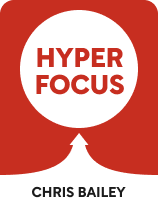

This article is an excerpt from the Shortform book guide to "Hyperfocus" by Chris Bailey. Shortform has the world's best summaries and analyses of books you should be reading.
Like this article? Sign up for a free trial here .
What is Chris Bailey’s Hyperfocus about? What is the key message to take away from the book?
In a world full of distractions, most modern-day knowledge workers believe that the secret to productivity lies in your ability to manage your time. In 2018’s Hyperfocus: How to Work Less to Achieve More, productivity expert Chris Bailey presents an alternate hypothesis: The key to becoming the most productive, creative version of yourself lies not in managing your time, but in managing your attention.
Here’s our review of Hyperfocus: How to Work Less to Achieve More by Chris Bailey.
Hyperfocus: How to Work Less to Achieve More
In his book Hyperfocus: How to Work Less to Achieve More, Bailey teaches two main methods of managing your attention. First, he presents several strategies to help you “hyperfocus,” or single-task, so that you can be as productive as possible. Then, he presents several strategies to help you “scatterfocus,” or intentionally mind-wander so you can be more creative and have more energy.
About the Author
Chris Bailey is a Canadian productivity expert. His first book, 2016’s The Productivity Project, was a Canadian non-fiction bestseller that chronicled the year-long productivity experiment Bailey undertook during his post-university sabbatical. Bailey also chronicled the experiment on his blog, which he continues under the name “A Life of Productivity.”
Connect with Chris Bailey:
The Book’s Publication
Publisher: Viking Penguin
Published in 2018, Hyperfocus is Bailey’s second book.
The Book’s Intellectual Context
Hyperfocus: How to Work Less to Achieve More came out in the late 2010s, a time during which many authors were writing about how to focus in a world increasingly driven to distraction. Bailey’s own The Productivity Project came out in 2016, as did Cal Newport’s Deep Work, which shares tips on how to deeply focus on work. Nir Eyal’s Indistractable, which also suggests strategies for doing focused work, came out in 2019—just one year after Hyperfocus.
The Book’s Critical Reception
Online reviewers who appreciate the book like how actionable Bailey’s advice is. They also appreciate that he cites substantial research for his ideas. Additionally, they like his tone, which they find easy to understand and not too stuffy.
Online reviewers who dislike the book primarily feel that Bailey repeats too many ideas he’d already shared in his first book, The Productivity Project. Some also find the book elitist due to some assumptions Bailey makes about his readers—like that they have a lot of control over their own schedules.
Commentary on the Book’s Approach
Hyperfocus: How to Work Less to Achieve More teaches you how to manage your attention partly by explaining the neuroscience of how attention works. Bailey gained this knowledge by reading scientific papers extensively—and perhaps in an attempt to simplify these papers for the layperson, he created unique words to refer to common concepts, such as “scatterfocus,” and “attentional space.” While well-intentioned, Bailey’s terms don’t exactly match those neuroscientists and other experts use, which sometimes makes it difficult to know what scientifically-backed concept he’s referencing when he’s using his own terminology.
Bailey’s simplification of the neuroscience of attention also manifests in imprecise (or absent) explanations of why or how these scientific phenomena work. This tendency weakens his argument: It’s not always clear how he came to a conclusion, and he often doesn’t explicitly address potential counterarguments. For example, he argues that if you develop a regular meditation practice, you’ll increase how often you deliberately direct your attention—but he never explains why that might be the case.
As discussed, many online reviewers complained that Hyperfocus was too similar to A Productivity Project—and indeed, most of Bailey’s conclusions in the first half of Hyperfocus reflect productivity techniques that may be familiar to fans of productivity books. The second half of Bailey’s book, which focuses on intentional mind-wandering and how it benefits creativity, is more unique, but it also reflects ideas in previously published texts: Notably, A Mind for Numbers shares a similar technique for accessing creativity, although it is geared towards students instead of businesspeople.
Commentary on the Book’s Organization
Bailey begins his book with a few introductory chapters that explain his interest in focus, his approach in the book, and several strategies his reader can use to focus better on the book itself. He then splits the book into two parts. In Part 1, Bailey describes the neuroscience of how your attention works, explains what hyperfocus is, and shares several strategies for accessing it. In Part 2, Bailey describes the benefits of scatterfocus and shares several strategies for it.

———End of Preview———
Like what you just read? Read the rest of the world's best book summary and analysis of Chris Bailey's "Hyperfocus" at Shortform .
Here's what you'll find in our full Hyperfocus summary :
- Why it's just as important to learn how to manage your attention, along with your time
- Why you still feel tired no matter how many breaks you take
- Strategies for managing your attention for better productivity and creativity





